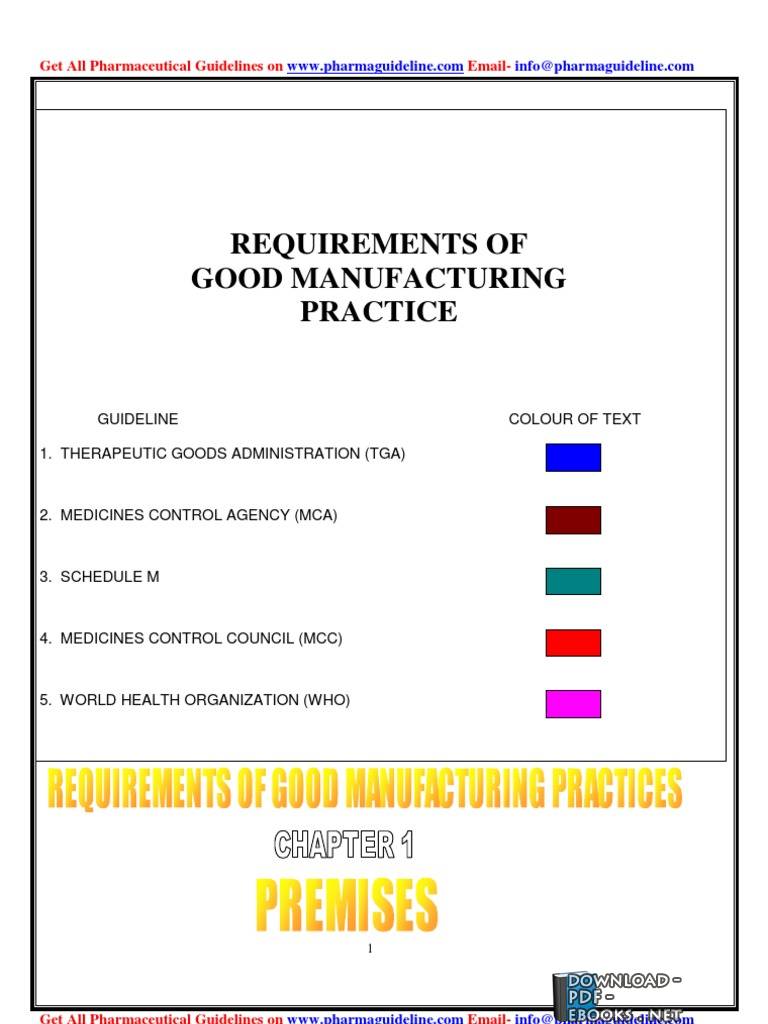📘 قراءة كتاب REQUIREMENTS OF GOOD MANUFACTURING PRACTICE أونلاين


REQUIREMENTS OF GOOD MANUFACTURING PRACTICE من كتب علمية
REQUIREMENTS OF GOOD MANUFACTURING PRACTICE
REQUIREMENTS OF GOOD MANUFACTURING PRACTICE من كتب علميةREQUIREMENTS OF GOOD MANUFACTURING PRACTICE
REQUIREMENTS OF
GOOD MANUFACTURING
PRACTICE
GUIDELINE COLOUR OF TEXT
1. THERAPEUTIC GOODS ADMINISTRATION (TGA)
2. MEDICINES CONTROL AGENCY (MCA)
3. SCHEDULE M
4. MEDICINES CONTROL COUNCIL (MCC)
5. WORLD HEALTH ORGANIZATION (WHO)
NOTE : (The number mentioned against each point is clause no. as per respective guidelines)
1. BUILDINGS AND GROUNDS
TGA:
a. General
101. Buildings should be located, designed, constructed, adapted and maintained to suit the operations
carried out in them.
Except where special precautions are taken to isolate an interior manufacturing space, buildings
should be sited away from incompatible activities such as those that generate chemical or biological
emissions.
102. Buildings, including receiving and despatch areas, should be designed, constructed and maintained
so as to protect against the effects of weather or ground seepage and the entry and harboring of
vermin, birds, pests and pets. Cavities and voids should not be present unless sealed or provided with
access for pest control.
103. Animal houses should be isolated from production areas, with separate entrances and air handling
facilities, and should comply with the current edition of the NH& MRC/CSIRO/AAC Code of
practise for the care and use of animals for experimental purposes.
104. Grounds should be established and maintained so as to minimize ingress into the buildings of dust,
soil or other contaminants and should be maintained in an orderly condition.
b. Pipes, ducts and service area
105. Pipelines carrying services or products between rooms or areas should be identified by colour or by
standard markings at suitable intervals and the direction of flow shown.
Particular care should be taken that product pipelines are not inter-connected or connectable in a
manner that invites cross-contamination or product mix-up.
“Dead legs” (in which circulation cannot occur) should be minimized.
106. In production areas –
* Extraction ducts should be designed to be cleanable and to prevent condensate or accumulated dust
from falling back into product or equipment.
* There should be no recesses that cannot be cleaned and a minimum of projecting ledges, shelves,
cupboards, pipes, fixtures and fittings
* Exposed overhead roof joists, pipes and ducts should be avoided. Where they are unavoidable,
special cleaning procedures and schedules should be written and followed.
* Exposed pipes should not touch walls, but be suspended from or supported by brackets, sufficiently
separated to allow thorough cleaning.
* Opening in walls, floors or ceilings through which piping, ducting or other non-structural items
pass should be sealed or have removable covers that permit cleaning.
* Light fittings should be located and/or sealed so as not to collect and deposit contamination.
107. Production areas should not normally contain service machinery, or its associated ductwork or
pipe-work, except where the ducting or pipes connect directly to equipment. Rooms or areas
CE
gmp pharmaceutical industry
gmp ppt
good manufacturing practice pdf
gmp بالعربي
gmp course
gmp pdf عربي
gmp airport
gmp معنى
حجم الكتاب عند التحميل : 3.1 ميجا بايت .
نوع الكتاب : pdf.
عداد القراءة:
اذا اعجبك الكتاب فضلاً اضغط على أعجبني و يمكنك تحميله من هنا:

شكرًا لمساهمتكم
شكراً لمساهمتكم معنا في الإرتقاء بمستوى المكتبة ، يمكنكم االتبليغ عن اخطاء او سوء اختيار للكتب وتصنيفها ومحتواها ، أو كتاب يُمنع نشره ، او محمي بحقوق طبع ونشر ، فضلاً قم بالتبليغ عن الكتاب المُخالف:
 قبل تحميل الكتاب ..
قبل تحميل الكتاب ..
يجب ان يتوفر لديكم برنامج تشغيل وقراءة ملفات pdf
يمكن تحميلة من هنا 'http://get.adobe.com/reader/'


 منصّة المكتبة
منصّة المكتبة